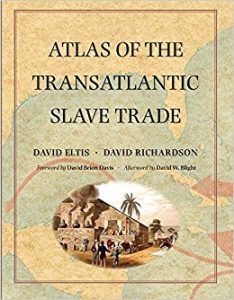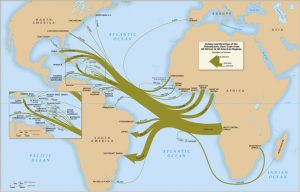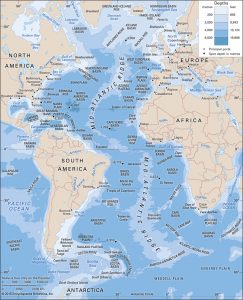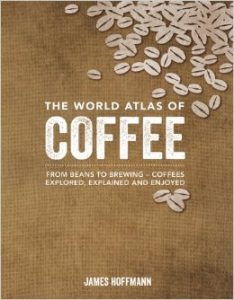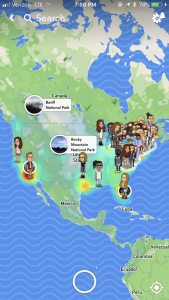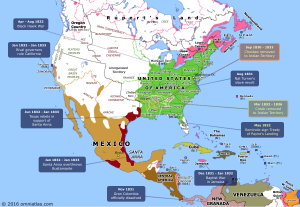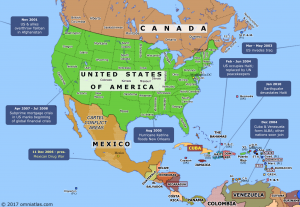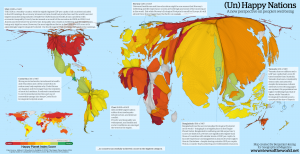
The title of my map is (Un) happy Nations, or (Un) happy planet as first named. This map was made by Benjamin Hennig, and is included in his book entitled, “Rediscovering the World: Map Transformations of Human and Physical Space”. The map is a unique and extremely drastic projection of the world. It presents such a biased, yet sensible opinion on the amount of happiness, or lack thereof, in these nations. The colors of this map tell the audience the level of unhappiness. With red meaning no happiness at all, orange and yellow representing a moderate level of happiness, and light and dark green being the highest level of happiness. Not only do the colors make a statement, but the countries’ shapes paint a picture to the readers as opposed to being your typical map. By shaping the nations as butterflies and tree branches and, with the addition of the variety of colors, these features mimic the look of the season of fall or spring. The many aspects and nuances of the social statement of this map causes it to become an interesting, thoughtful, and extravagant map.
First, let’s dig into the colors of this map. So, the legend that you see is the measurement of each country’s Happy Planet Index (HPI) Score. Red represents the nations with the lowest amount of happiness—the United States, parts of South and West Africa, Russia, and scattered parts of Europe and Asia all are colored in red. The colors of each country says a lot and provides contemplative thoughts. Each color was based upon the score all 140 countries, accounted for, received. In comparison to other countries, it does not surprise me that the U.S. would be one of a few countries with the lowest happiness score. Russia is pretty unexpected, I did not expect for it to have been colored by the second darkest shade of red on the spectrum, I was expecting a lighter color, like orange. The brightest, happiest colors are mainly in South America, Mexico, and countries in Latin America. This area has the colors green and yellow, representing moderate to high levels of happiness. Costa Rica has the darkest shade of green on the map, representing the happiest country.
The map is also distorted in a very extravagant way, with various factors that contribute to the message of the map. Instead of drawing the countries based on their size, population, or GDP, the mapmaker does something different by distorting the countries based on its Happy Planet Index score. This results in the inclusion and subsequent bashing of countries for their, “unstable economic developments, rising inequalities, and environmental change”. In addition, the countries in the map are completely skewed and several countries are enlarged or minimized, leading to the assumption that the map maker would rather them seem generally less or more important. The western hemisphere is definitely minimized and relatively smaller than it is in the most common map projections of the world. Canada, especially, is tremendously condensed, as well as Russia. Countries in Asia, like Bangladesh and China, are enlarged and cover a big part of the map, they attract the eyes of the audience and are clearly an important part of the map. Mexico is also very large, and even looks to be the same size, or larger, than the United States. The reason behind these drastic, and intentional, distortions are clearly due to the amount of happiness in each country and causes the readers to picture a world where happiness is a crucial factor. Of course, this would alter where all the tourists went for Christmas break– if they were under the impression that the amount of happiness in a country coincided with the level of hospitality and fun, it would influence their decisions. The countries with the relatively lower scores of happiness are much more distorted than the ones that are colored yellow or green and have relatively higher scores of happiness. However, not all countries that have light colors and high happiness scores, are as enlarged as the specific countries that the map maker has chosen to distort. Not even the country with the highest score of happiness, Costa Rica, is as proportionally enlarged as the others. Although Costa Rica is the country with the highest level of happiness, because it is not a superior country or a country of global importance compared to the U.S. or Russia, it is not enlarged or projected the way it should be based on the credits of this map. The way that the mapmaker decided to color the countries definitely signals to the audience the ‘good’ and ‘bad’ countries, and the way they are spatialized definitely adds to this impression. It is creative that the mapmaker decided to turn happiness into a geographic variable, and I believe he does this explicitly and effectively by choosing the colors that he did.
The shapes of the continents on the map are also very distinct. The countries are shaped as a butterfly, tree branch, bird, and various shapes that give the notion of fall or spring, seasons that are calm, cool, yet colorful and vibrant. The shape of this map must have been intentional and the map maker chose these shapes so that the audience could relate to the view which the mapmaker believes about this topic. This sort of projection is very unique and displays a purposeful message to the audience that encourages them to think of certain countries as better than others. A higher level of happiness implies that it will be a great country.
The map maker also chose six countries to highlight, by writing a small summary consisting of some facts on the country, its issues, and, for some, positive attributes of the country. The first country, Costa Rica, has the highest amount of happiness in comparison to the others and is described in a positive and praising manner. The map maker emphasizes that the country has a deep connection to nature, which could contribute to it being a very happy country, and it compares the fact that people who live there often live longer than in most rich nations. Also, the map points out Chad which received the 140th of 140 score on the happy planet index. The map maker continues to explain the issues of the country, some being the worst in the region, and the summary of Chad is also relatively short and would not cause someone to feel positive towards the country. The mapmaker decides to include these summaries in his map in order to fulfill his political idea of happy countries being better off than countries who may not be so fortunate in the category of happiness. In addition, the idea is also suggested that if a country is not happy it cannot be successful and is therefore not equal to the other, happier, countries.
This map is one of many aspects and carries a unique message comparing countries based on their levels of happiness. Happiness is one aspect of life that people often overlook or do not view as something important. It is particularly interesting that the map maker decides to choose a topic as simple as happiness, and then distorts and discredits countries for not keeping their citizens completely happy. This is definitely a special kind of political map that I’m sure many of us have yet to come across, until now. This map definitely opens the eyes of the audience and causes them to view these countries in a unique way, categorizing them according to their level of happiness.
Sources:
http://geographical.co.uk/places/mapping/item/2057-un-happy-planet – Published by Benjamin Hennig January 21, 2017
http://www.viewsoftheworld.net/?p=5376#more-5376 – Published by Benjamin Hennig March 20, 2017
https://ideas.ted.com/7-thrillingly-new-perspectives-on-the-world-and-how-we-live-today/ – Published by TedTalk December 22, 2016

